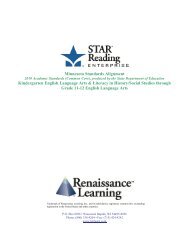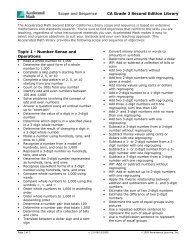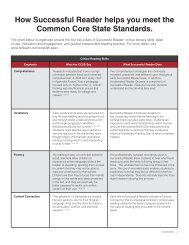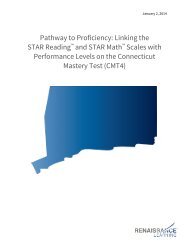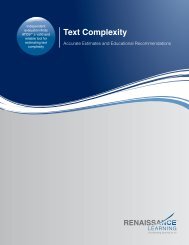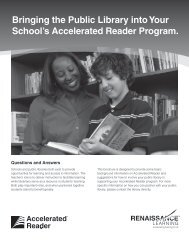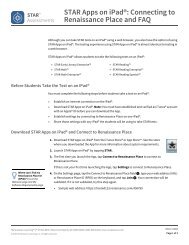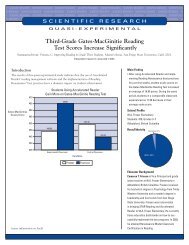Technical Manual - Renaissance Learning
Technical Manual - Renaissance Learning
Technical Manual - Renaissance Learning
Create successful ePaper yourself
Turn your PDF publications into a flip-book with our unique Google optimized e-Paper software.
STAR Early Literacy Enterprise in the ClassroomMeasuring GrowthAbsolute Growth and Relative GrowthIt is important to distinguish between two types of academic growth (or gains)that may be evidenced in test results. Absolute growth reflects any and all growththat has occurred. Relative growth reflects only growth that is above and beyond“normal” growth (i.e., beyond typical growth in a reference or norming group). Ingeneral, norm-referenced scores, such as percentiles, only indicate relativegrowth. As it is not a norm-referenced test, STAR Early Literacy Enterprise scoresdo not measure relative growth. Its criterion-referenced Scaled Scores,Sub-domain Scores, and Skill Set Scores all reflect absolute growth. The GrowthReport in STAR Early Literacy Enterprise provides administrators, teachers, andparents with information about students’ absolute growth in literacy skills.Information about students’ absolute growth is more useful than relative growthbecause it helps educators and parents evaluate the effectiveness of learningactivities and make the adjustments that will promote appropriate development.The Pretest-Posttest Paradigm for Measuring GrowthFor many classroom purposes, STAR Early Literacy Enterprise is the ideal tool tomeasure the progress of individual students. It is self-administered for moststudents, can be administered frequently, and provides a snapshot of a student’sabilities over time.On occasion, however, educators may want to use STAR Early Literacy Enterpriseto evaluate the effectiveness of a specific intervention, such as a new textbook orinstructional philosophy. In general, most educational program evaluationdesigns attempt to determine if relative growth has occurred. That is, they areattempting to measure the impact of the intervention, or program, above andbeyond normal growth (i.e., above and beyond what you would expect to occurwithout the intervention). This approach is not easily applicable using STAR EarlyLiteracy Enterprise because, by design, it does not provide an index of “normal”growth. STAR Early Literacy Enterprise can be used to evaluate growth, however,by means of a pretest-posttest paradigm with a control group.The logical method for measuring growth (i.e., measuring effectiveness ofeducational interventions) is through the use of a pretest-posttest design. In sucha design, each student is administered a test prior to the beginning of theintervention to establish a baseline measure.Then, each student is measured again at a later point in time (usually with adifferent, but equated, “form” of the same test) to see if the intervention isproviding the desired outcome. The follow-up measurement may be at the end ofthe intervention, or may be done periodically throughout the course of the newprogram. Certainly, all of the issues relating to the adequacy of the test itself (e.g.,STAR Early Literacy<strong>Technical</strong> <strong>Manual</strong>134





